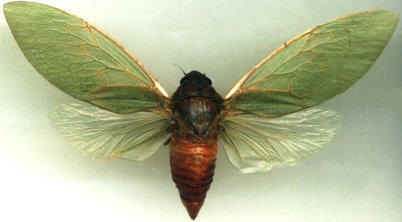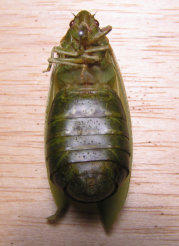
Bladder Cicada
Cystosoma saundersii Westwood, 1842
© Popple Creative Industries 2014–2025
Male
Female
Species number (TNS):
596.
Fore wing length:
38–51 mm.
Distribution and seasonality:
Known from the Atherton Tableland and
west of Mackay in north Queensland,
from Carnarvon National Park in inland
Queensland and coastally and
subcoastally south from Kroombit Tops
in central Queensland to Sydney in New
South Wales. It has been inadvertently
introduced to Canberra in the Australian
Capital Territory and to Lord Howe
Island. Adults are present from August
to May.
Notable localities:
Kuranda, Atherton, Toowoomba, Mount
Tamborine, Stanthorpe, Armidale,
Burwood (D. Emery).
Habitat:
Subtropical bushland, rainforest, riparian
forest. Often occurs in introduced
Lantana (Lantana camara).
Calling song and behaviour:
A very low pitched, guttural growl. The
song is not completely continuous and
has momentary pauses. Singing occurs
at dusk and early after nightfall. Adults
sit in the foliage of leafy trees and
shrubs.
Colour variation:
Adults are entirely dark green in life,
with a rare blue mutant having been
found on one occasion (Queensland
Museum).
Similar species:
Rare Bladder Cicada, Daintree Bladder
Cicada, Small Bladder Cicada (species
complex).


dr-pop.net database record
Currently known extent
Habitat










